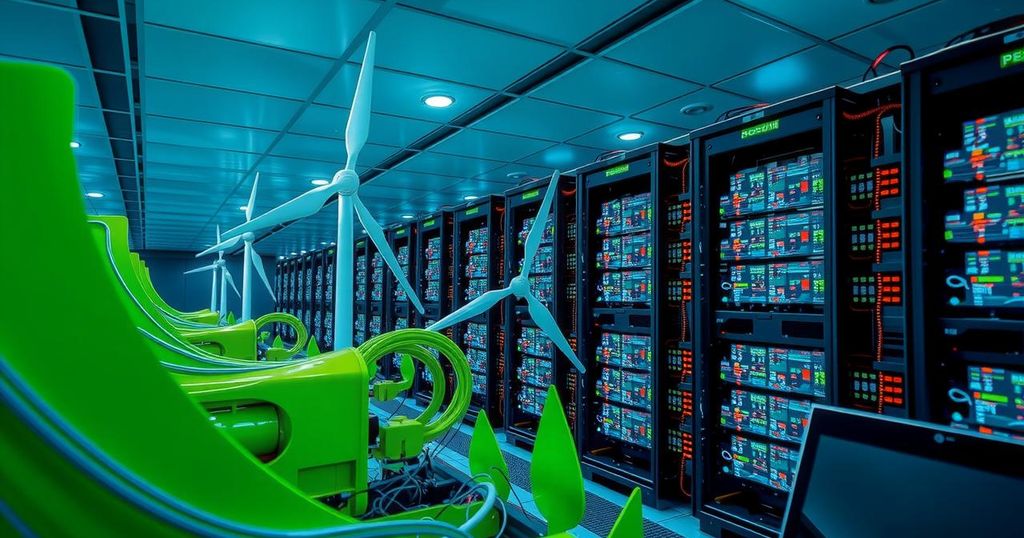Data centers are driving a shift towards renewable energy with US facilities accounting for 50% of corporate clean energy procurement, while Europe lags at about 20%. By the end of Q3 2024, US data centers are set to secure over 50 GW of clean energy, mostly from solar and wind. The report highlights significant clean energy procurement strides in Europe by large tech companies, with Spain leading the market as traditional demand hubs like Frankfurt and London adopt renewable PPAs.
In the ever-evolving landscape of energy demand, data centers have emerged as powerful harbingers of a new era, driving a significant shift towards renewable energy sources. A recent report by S&P Global Commodity Insights underscores this transformational journey: in the United States, data centers proudly account for a staggering half of all corporate clean energy procurement. In stark contrast, European data centers lag behind at roughly 20% of corporate clean energy contracts. The report, shared on October 30, highlights a remarkable feat: by the end of the third quarter of 2024, US data centers are projected to have contracted at least 50 gigawatts (GW) of clean energy. Of this, solar energy leads the charge with 29 GW, followed by wind energy at 13 GW, while hybrid and nuclear solutions are gaining momentum. Europe, on the other hand, is represented by major tech giants such as Amazon, Google, Microsoft, and Meta, collectively procuring over 12 GW. Notably, Spain has claimed the title of Europe’s clean energy champion, with a focus on solar, complemented by offshore wind power purchase agreements (PPAs) dominating the Frankfurt-London-Amsterdam-Paris (FLAP) corridor. Despite the advancement in renewable energy contracts, Europe’s pace pales in comparison. “Data centers and large tech companies have significantly increased their clean energy procurements in Europe so far in 2024, contracting approximately 5.3 GW compared to 3.7 GW for all of 2023. Their role is comparable to that of the industrial sector,” remarks Bruno Brunetti, Environmental Markets and PPA Analytics lead at Commodity Insights. He paints a picture of a rapidly evolving landscape where sustainability is the cornerstone of energy ambitions. Further breaking down the statistics, it is noted that while PPAs remain the predominant means of energy sourcing among major tech players in North America, European enterprise data centers adopt a diverse mix of procurement strategies. This varied approach reflects the brewing competition and ambition among data centers to carve their sustainability narratives. According to the report, the incremental power demand within the next five years could see data centers contracting over 300 terawatt-hours (TWh) of PPAs, with North America leading the charge, followed closely by Asia-Pacific and Europe – an impressive shift in a global market projected to reach 600 TWh per year. Each of these figures unfolds a tale of growth, particularly in Europe where conditions suggest data centers could source between 70-100 TWh of renewables by 2030, amplifying the current contracted figure of just 30 TWh. “Given their sustainability ambitions and demand needs, data centers will lead in the adoption of new procurement solutions,” Brunetti emphasizes, hinting at a future characterized by hybridization and multi-technology approaches more vividly seen in the US. As the digital world expands, fueled by increasing reliance on data centers, forecasts from 451 Research envision European data center demand doubling from an average of 10 GW in 2019 to 20 GW by 2026. Within this short span, the sector will grow by approximately 25%, signaling a crucial shift in how energy is consumed and optimized across local and national boundaries. Amidst this rapid expansion, Germany and the UK have recorded the most significant growth, with demand centralized around financial hubs. The average size of data centers has noticeably increased from the 15-30 MW range in the late 2010s to a current 50-100 MW spectrum. As this phenomenon progresses, the capacity for flexible energy responses will become paramount, enabling data centers to adapt to fluctuating energy prices and demand. Currently, Spain stands out in the European market, procuring 4.7 GW in total for data centers, with solar energy making up a substantial 60%. Following closely, Ireland has contracted 2 GW while the FLAP region accommodates 4.5 GW, predominantly sourced from wind. The narrative of data centers and their role in driving clean energy procurement offers a glimpse into the future of sustainable energy, where innovation, demand, and environmental responsibility converge to forge a better path forward.
The article explores the current state of clean energy procurement in data centers, emphasizing the stark differences between the US and Europe. This disparity reflects regional energy policies, market maturity, and the presence of major tech companies transforming the energy procurement landscape. The insights provided by S&P Global Commodity Insights outline the crucial role of data centers in shaping the future of renewable energy sourcing, showcasing various procurement methods such as power purchase agreements (PPAs) and other emerging strategies aimed at increasing sustainability.
In conclusion, the evolution of data centers as significant players in the renewable energy space marks a pivotal turning point for sustainable energy procurement. As evidenced by contrasting figures between the US and Europe, there is a clear path towards enhanced sustainability practices. The rapid increase in demand for clean energy, particularly in large tech companies, highlights the importance of evolving procurement strategies to meet ambitious sustainability goals. By leveraging a mix of PPAs and innovative approaches, data centers are not only adapting to energy demands but are also leading the charge in the green energy transition, promising a more sustainable future in the energy market.
Original Source: www.spglobal.com

Leave a Reply